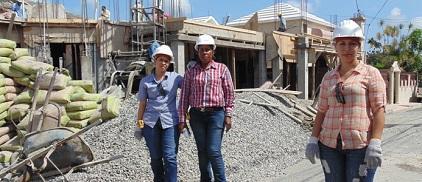
A focus on women is the route to reducing the threat of disasters, according to top speakers at the Global Platform, a fact underlined by the successes of programmes such as this safe construction course in the Dominican Republic (Photo: EU-ECHO)
By Jonathan Fowler
CANCUN, Mexico, 26 May 2017 – Countries around the world need to focus on women if they are to achieve the aims of a 15-year agreement to curb hazard impacts, according to delegates at the 2017 Global Platform for Disaster Risk Reduction.
The Global Platform, hosted by the Mexican government, has drawn thousands of delegates who are assessing efforts to implement the Sendai Framework for Disaster Risk Reduction, adopted at a UN conference in 2015.
The Sendai Framework has seven targets. It aims to bring about substantial reductions in disaster deaths, the number of affected people and economic losses, plus damage to critical infrastructure and disruption to basic services such as health and educational facilities.
It also seeks to increase the number of countries with national and local risk reduction strategies – by 2020, the earliest deadline in the framework and a key step for meeting the other targets – as well as bolstering the capacity of developing countries, and vastly increasing coverage by early warning systems.
“We’re going to have to emphasize women’s empowerment if we’re going to achieve these goals,” said Ms. Laura Tuck, the World Bank’s Vice President for Sustainable Development.
The Sendai Framework Framework puts gender front and centre due to its whole-of-society approach.
Disasters affect men and women, and boys and girls, differently for an array of reasons.
“Disasters are unfair. They discriminate,” said Mr. Elhadj As Sy, the Secretary-General of the International Federation of Red Cross and Red Crescent Societies (IFRC).
For example, gender inequalities can hamper the influence and control of women and girls over decisions governing their lives and those of their families. And due to socio-economic conditions, cultural beliefs and traditional practices, women and girls are more likely to be affected if a hazard strikes, facing increased loss of life and livelihoods, and gender-based violence, during, and in the aftermath of, disasters.
“We must cut the roots of discrimination wherever they appear,” said Ms. Amina J. Mohammed, Deputy Secretary-General of the United Nations.
The figures are stark from disasters such as the 2004 Indian Ocean Tsunami, where women and children made up 77% of the victims in Indonesia, or the Solomon Islands’ own deadly wave of 2007, where the proportion was 96%. And in Bangladesh’s Cyclone Gorky disaster of 1991, women outnumbered men by 14 to 1.